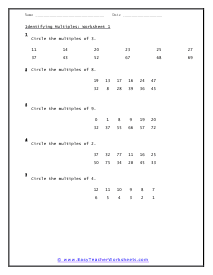What are Multiples? A lot of students confuse multiples with factors, even though these are totally different terms in mathematics. When we multiply a number with an integer, we get multiples. The integer here is not a fraction. Factors, on the other hand, are the numbers that multiplied together to produce another number. Consider an example; 5 × 4 = 20. Here 20 is multiple of both 4 and 5. While 4 and 5 are factors of 20. It is how you can differentiate between a factor and a multiple. To understand multiples, knowing the difference between these two is the right way to proceed.
This collection focuses on understanding what a multiple is. Multiples are a numbers that are exactly divisible by another number. They always result in an even division with no left over remainder. Every number is divisible by itself and one. Besides zero and fractions this holds true. This leads us to understanding the construct of times tables. These worksheets explain how to identify the factors and multiples of a given number. Students will also identify the missing factors or multiples from a set.

















